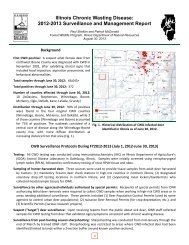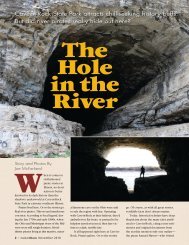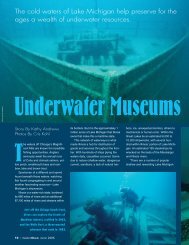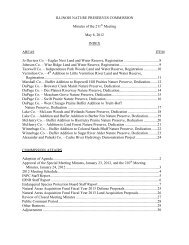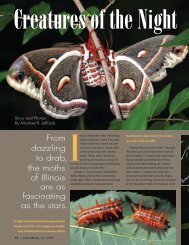OutdoorIllinois September 2007 Big River State Forest - Illinois DNR ...
OutdoorIllinois September 2007 Big River State Forest - Illinois DNR ...
OutdoorIllinois September 2007 Big River State Forest - Illinois DNR ...
You also want an ePaper? Increase the reach of your titles
YUMPU automatically turns print PDFs into web optimized ePapers that Google loves.
ski or to spend a day angling for sunfish,bass or catfish, boaters will find boataccess areas at <strong>River</strong>view Campground(low water can make access difficult partof the year) or a mile south of the campgroundat Putney’s Landing.According to Tony Newton, <strong>Big</strong> <strong>River</strong>site superintendent, sportsmen haveample opportunity to visit the forestthroughout the year.“During the winter months, uplandgame and raccoon hunters sign in at thepark headquarters before venturingafield, and return to report their harvestat the end of their hunts,” Newtonexplained. “In the spring, the forest isdivided into six sections, with turkeyhunters who have received a site-specificpermit trying their luck at calling agobbler into range.”Early fall has 100 dove hunters drawingfor a numbered post on opening day,after which they need only stop by theoffice daily to sign in and out. Fall turkeyand archery and shotgun deer huntinground out the offerings.<strong>Big</strong> <strong>River</strong> <strong>State</strong> <strong>Forest</strong> holds seasonalvariety for visitors. In the fall, scrub oaksset the prairie ablaze with color. Wintervisitors find quiet trails for cross-countryskiing through snow-draped pineboughs, bald eagles perched in a riversidetree, or, if snow levels permit, a sitefor an exhilarating snowmobile ride.Spring wildflowers bring color to theprairie, and the heat of summer finds visitorsenjoying cooling breezes from thedeck of a boat or under fragrant pines.Whether exploring the region for itshistory or natural resources, a stop at<strong>Big</strong> <strong>River</strong> <strong>State</strong> <strong>Forest</strong> will be a highlightof your next trip.A Brief GeologicHistory of theArea of <strong>Big</strong> <strong>River</strong><strong>State</strong> <strong>Forest</strong>riving along or floating down theDMississippi <strong>River</strong>, you may think ofpast cultures that relied on the river forfood, shelter and transportation. Thisrich cultural history of the Mississippi<strong>River</strong> Valley is the most recent reflectionof the complex and intriguing geologichistory of the river and the area.The area of <strong>Big</strong> <strong>River</strong> <strong>State</strong> <strong>Forest</strong>,with its peaceful pine forests and riversidecampgrounds, provides andexcellent opportunity to see the varietyof geologic materials and landformsthat have developed from the forces ofthe mighty Mississippi. Engineeredlevees, locks, and dams contain theriver in many places, but they are ultimatelyno match for the relentlessearth-moving power of the Mississippi<strong>River</strong> through geologic time.Almost all of what we see on theland surface near <strong>Big</strong> <strong>River</strong> <strong>State</strong> <strong>Forest</strong>today is a result of geologicprocesses that occurred during theQuaternary Period. During this time,continental-scale glaciers repeatedlycovered the area of <strong>Big</strong> <strong>River</strong> <strong>State</strong><strong>Forest</strong> and altered the course of theMississippi <strong>River</strong> several times. Theriver was one of the major outlets forglacial meltwater, and the river’scourse today is very different fromwhat it has been in the past. Prior tothe most recent glaciation (about21,000 years ago) and during thetimes between older glaciations (120-150,000 years ago and >500,000years ago), the ancient Mississippi<strong>River</strong> flowed southward toward thearea of the Quad Cities but turnedsoutheastward near Clinton, Iowa andflowed across the Green <strong>River</strong> lowlandsto join what is now the <strong>Illinois</strong><strong>River</strong> near the great bend of the <strong>Illinois</strong>above Peoria. So, the valley ofthe lower part of the modern <strong>Illinois</strong><strong>River</strong> through central <strong>Illinois</strong> was originallycovered by the ancient Mississippi<strong>River</strong>. During these times, theancient Iowa/Cedar river flowed southeastwardthrough Iowa and enteredwhat is now the modern Mississippi<strong>River</strong> valley just south of Muscatine,Iowa. This river flowed through what isnow the area of <strong>Big</strong> <strong>River</strong> <strong>State</strong> <strong>Forest</strong>and joined the ancient Mississippi<strong>River</strong> near St. Louis. During the mostrecent glaciation (about 21,000 yearsago), glaciers moved across <strong>Illinois</strong>from the Lake Michigan basin anddammed the Ancient Mississippi <strong>River</strong>near Hennepin in Marshall County.When this happened, a large lakeformed in the Green <strong>River</strong> lowlandsbetween the Quad Cities and Hennepin.This lake ultimately spilled overinto the ancient Iowa/Cedar river valleyand re-routed the Mississippi <strong>River</strong>into its current path and through thearea of <strong>Big</strong> <strong>River</strong> <strong>State</strong> <strong>Forest</strong>.Today in the Mississippi <strong>River</strong>Valley, most of the landforms areassociated with events during andafter the most recent glaciation andstudying these landforms can helpunravel the geologic history. Forexample, terraces are the remains ofancient floodplains formed at higherelevations when the river was chokedwith the sediment and water gushingfrom the melting glaciers. When theriver lost its abundant sediment supply,due to glacier retreating, the riverdowncut and left behind terraces thatreveal the former river level. Theseflat, continuous surfaces are easy tosee near and in the forest. Parts of anold terrace are located high in theriver valley along the eastern bluff,particularly just north of Bald Bluff.This terrace is thought to be associatedwith the re-routing of the AncientMississippi <strong>River</strong> about 21,000 to18,000 years ago. <strong>Big</strong> <strong>River</strong> <strong>State</strong><strong>Forest</strong> is situated on a large, youngerSand dunes created by glacial deposits from the ancientMississippi <strong>River</strong> are readily evident throughout the area.terrace of the Mississippi <strong>River</strong>, whichformed between 18,000 to 12,000years ago. This terrace likely formedas the continental glaciers meltedback from <strong>Illinois</strong>, Wisconsin and Minnesotafor the last time, and the sedimentsupply to the Mississippi <strong>River</strong>decreased. The terrace is about 30feet above the current river level andis composed of thick, sandy, riverdeposits that are capped by large,wind-blown dunes that trend northwest-southeast.These dunes likelyformed when large quantities of siltand sand were transported within theriver valley during the waning stagesof glaciation. Look for these dunes onthe east side of the Oquawka-Keithsburgblacktop just south of the rangerstation and you will see an undulating,sandy surface overlain by thepine forest. Approximately 20 feet ofthe same wind-blown silt and sanddeposits also lie atop Bald Bluff to theeast of the forest, and wood and otherorganic materials in these depositshave been radiocarbon dated to beabout 13,700 years old.Another geologic feature, preservedas a broad, low-lying valleylocated between the dune-coveredterrace and the eastern valley wall, isvisible when traveling from the stateforest toward Bald Bluff. This valley,called the Edwards <strong>River</strong> paleochannel,is an abandoned stream channelthat was active between 12,000 and10,000 years ago. It is filled withsandy stream deposits that includelayers of reddish-brown clay. Remarkably,these clay beds reflect floodingevents that originated from the LakeSuperior region during the last glacierretreat. Ultimately, as glaciers retreatedfurther north out of <strong>Illinois</strong> andbeyond the Great Lakes Region about12,000 to 10,000 years ago, the Mississippi<strong>River</strong> likely began its transitionfrom a glacial meltwater braided-riversystem to an island braided system,and by about 7,000 years ago, theriver had likely attained a channel patternsimilar to the modern river.The complex history of the Mississippi<strong>River</strong> and its valley is difficult tounravel, but it helps us understand theorigins of the beauty that we see in <strong>Big</strong><strong>River</strong> <strong>State</strong> <strong>Forest</strong> and the surroundingarea. So, while hunting, camping, boatingor hiking in <strong>Big</strong> <strong>River</strong> <strong>State</strong> <strong>Forest</strong>look for the evidence of an excitinggeologic history that made the parkwhat it is today.— Compiled by Jason Thomasonand Joan Jach of the <strong>Illinois</strong> <strong>State</strong>Geological Survey12 / <strong>Outdoor<strong>Illinois</strong></strong> <strong>September</strong> <strong>2007</strong>




